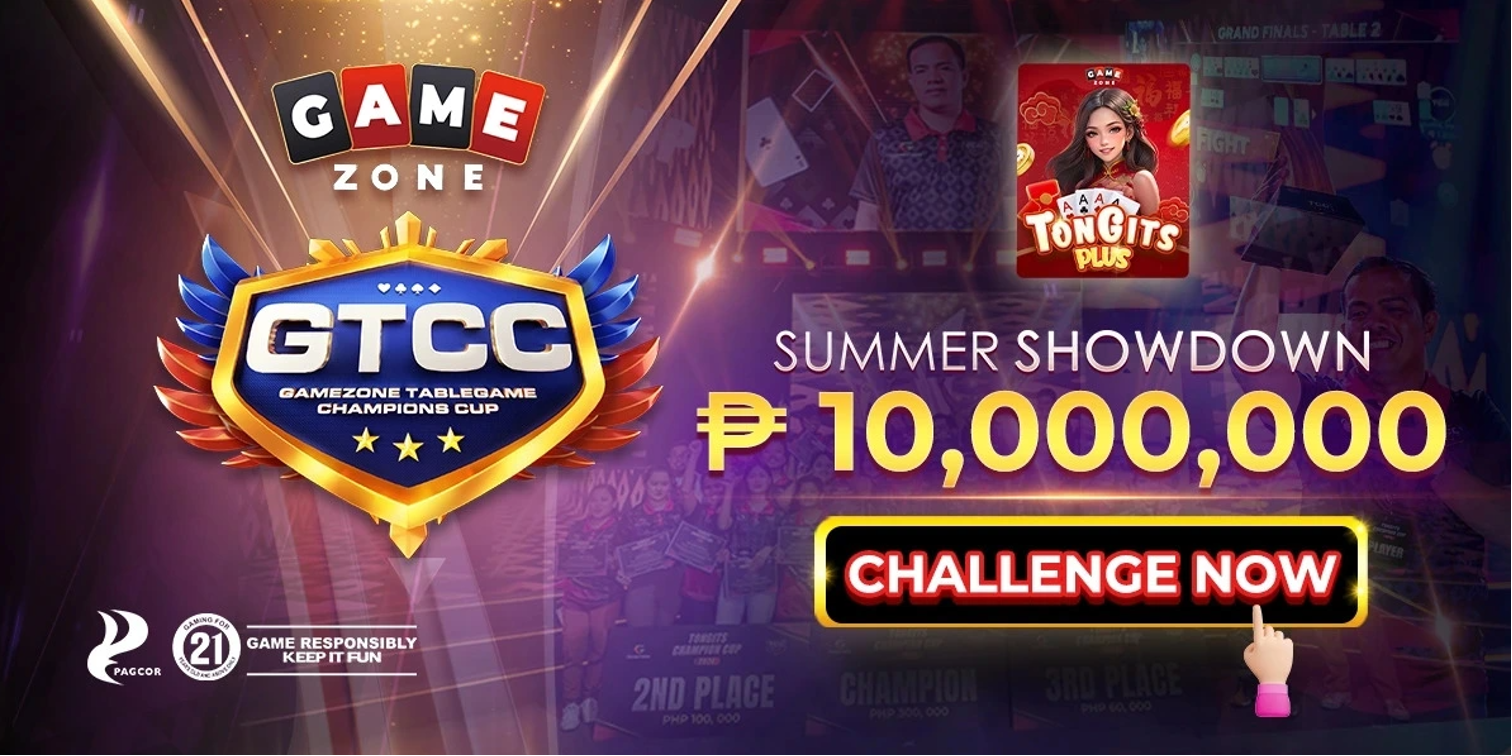The GameZone Tablegame Champions Cup (GTCC) has brought our favorite card games into the polish and prestige of a major tournament, a high-stakes battleground bridging tradition with modern gameplay.
In neighborhoods across the Philippines, card games are more than entertainment; they’re a shared language. Tongits and Pusoy Dos have long served as both a pastime and a performance, where laughter, rivalry, and legacy unfold with every shuffle.
But in recent years, Game Zone online games have made it more convenient and accessible for players to hone their skills in their respective games, playing with more focus as they carry the chip on their shoulder.
This isn’t just a tournament; it’s a redefinition of how we view Filipino card culture, and for the first time, players from all walks of life are competing not just for bragging rights but for national recognition.
And at the heart of it all is a deeper current: the desire to legitimize our own. For decades, games like Tongits existed on the margins, unregulated, informal, and often dismissed.
But now, through GTCC, they’re being given a stage worthy of their complexity. The games haven’t changed, but the way we see them has, and that shift matters.

From Street Corners to Center Stage
Tongits has always thrived in the nooks of Filipino life, played in sari-sari store alleys, on upturned bottle crates, and in the soft buzz of barkadahan laughter.
It’s a game of instinct, of knowing your kaibigan’s tells better than your hand. And for decades, that was enough. It didn’t need lights, sponsors, or a podium. It needed players, a pack of cards, and a reason to gather.
But in the age of organized esports and digital tournaments, the question slowly emerged: what if Tongits wasn’t just casual fun? What if it were something more, like an arena of intellect, reflex, and national pride?
That question gave rise to the GameZone Tablegame Champions Cup (GTCC), an offline Tongits MTT (multi-table tournament) backed by GameZone casino and built to elevate grassroots brilliance. It was never about reinventing the game; it was about giving it a platform.
The Tongits free multi-table tournament format allowed everyday players to compete under a pro-level structure, with high-stakes progression and one big promise: anyone can become a champion.
This change wasn’t cosmetic. Every round of the GTCC represents a shift in perspective. Gone are the informal pauses and on-the-fly house rules. In their place: tournament clocks, certified marshals, and verified players operating under standardized regulations. There’s no room for ambiguity; only clarity, focus, and execution.
And with stakes as high as a ₱5 million top prize and national bragging rights, players are adapting fast.
Veterans are sharpening their strategies, learning to count discards like chess pieces. Newcomers are bringing data-backed analysis to age-old instincts. The GTCC isn’t just preserving the game; it’s raising the skill ceiling.
This transformation also fosters a new kind of community, one built not just on camaraderie but on shared ambition. In social media groups, forums, and even coffee shop meetups, players now dissect GTCC matches the way sports fans review classic finals.
Terms like “bluff rhythm,” “trap discard,” and “soft draw delay” are entering the everyday vocabulary of Tongits tournament enthusiasts. Through the GTCC, Tongits is becoming more than a pastime; it’s evolving into a discipline with a language, a culture, and a future.

From Casual to Canon: How the GTCC Is Building a Legacy
One of the most compelling things about the GameZone Tablegame Champions Cup (GTCC) is how it positions itself, not just as a competition, but as a cultural milestone.
It doesn’t merely elevate Tongits from a casual barkadahan favorite to a high-level contest; it builds a tradition around it. With each annual edition, the GTCC isn’t just holding a tournament; it’s telling a story.
It’s writing a new chapter in how we view Filipino card games: not as disposable pastimes, but as canon-worthy formats deserving of structure, spotlight, and serious recognition.
That recognition is tangible. From the vast coverage of GameZone online to the concentrated showcase of talent in GameZone’s offline GTCC format, players receive the kind of credibility usually reserved for more mainstream esports. We’re talking verified IDs, ranked brackets, official marshals, and standardized decks.
This is no underground league. This is Tongits, professionalized.
And it’s all taking place in live venues, where players sit face-to-face, reading each other’s expressions, calculating discards, and managing pressure in real time.
That tactile, offline nature of the tournament gives it weight. It restores a kind of rawness that online tournaments can’t replicate, and that’s where the GTCC shines brightest.
The result? An ecosystem where old-school skill meets modern discipline. Veteran players now go toe-to-toe with a new generation of Tongits minds who’ve studied the game like it’s a sport. Some have even turned to recorded matches and fan analysis for prep.
And with a ₱5,000,000 cash prize waiting at the end of the bracket, there’s every reason to train harder, think deeper, and aim higher. The GTCC doesn’t just reward instinct; it rewards evolution.
And perhaps the biggest evolution isn’t in the gameplay, but in the mindset. GTCC players are no longer just “magagaling sa Tongits.” They’re tacticians, athletes of focus, and artists of the bluff. They study playstyles, strategize under pressure, and earn respect through performance.
This shift in identity from hobbyist to professional is what sets the GTCC apart. It’s not a nostalgia act. It’s a declaration: Tongits belongs on the national stage, and the GTCC is how it gets there.
A Game Rewritten by Purpose
What the GTCC represents goes beyond spectacle; it represents stewardship.
In an age where traditional games risk fading into footnotes, GTCC brings Tongits into sharp focus, not as a relic, but as a rising standard. It takes the chaos and charm of perya-side play and fuses it with structure, pride, and forward momentum.
For players, it’s a shot at glory. For the community, it’s a moment of recognition. And for Filipino culture, it’s a reminder that our games carry weight, complexity, and the potential to stand tall alongside the world’s best.
With every shuffled deck and decisive draw, GTCC is writing a new chapter, not just for Tongits but for the broader legacy of Filipino card games. It’s not just a tournament. It’s a movement. And it’s only getting started.




